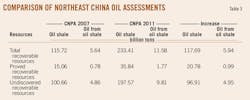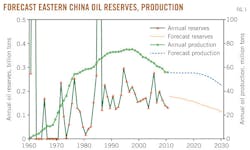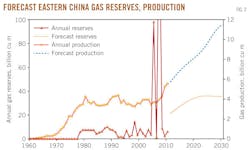Chenglin Liu
Chinese Academy of Geological Science
Beijing
Changbo Che Jie Zhu Fulin Yang
Ministry of Land and Resources
Beijing
Shaoqing Wang
China University of Petroleum
Beijing
China has begun the annual national oil and gas resources assessment after China's National Petroleum Assessment 2007.
Based on previous assessments, China's National Petroleum Assessment 2011 has evaluated conventional oil and gas, oil shale, and shale oil resources in the Songliao basin and its surrounding medium and small-scale basins and the Liaohe depression of the Bohai Bay basin in northeastern China by using the petroleum resource assessment software system developed by China's National Petroleum Assessment 2007 and updated in recent years.
The assessment results show that oil and gas recoverable resources in northeastern China are 7.22 billion tons of oil and 2.46 trillion cu m of gas and that total oil and gas recoverable resources in China are 24.58 billion tons of oil and 33.76 trillion cu m of gas.
Oil and gas recoverable resources in northeastern China make up 29.37% and 7.29%, respectively, of the total of China.
Oil shale and oil from oil shale recoverable resources in northeastern China are 233.4 billion tons and 8.66 billion tons, respectively. Shale oil in-place resources in the Gulong area of the Songliao basin are 1.15 billion tons.
It is forecast that the annual oil proved reserves will sustain the current level and the annual gas proved reserves will increase at a fast rate in northeastern China before 2030. Oil production will exceed 56 million tons/year before 2020 and reach 45 million tons/year at the end of 2030. Gas production will be 26 billion cu m/year at the end of 2030.
Introduction
The US Geological Survey estimated mean volumes of undiscovered conventional petroleum resources in six geologic provinces of China, at 14.9 billion bbl of oil, 87.6 trillion cu ft of natural gas, and 1.4 billion bbl of natural gas liquids in 2012.1
These six provinces are the Junggar, Bohaiwan, Ordos, Sichuan, Songliao, and Tarim basins.
Liu compared the USGS 2000 assessment 2000 and China's 2007 National Petroleum Assessment and found that six major factors contributed to the differences in the two assessments.2
The six major factors are petroleum resource classification systems, data sources, assessment scopes, unit divisions, assessment methods, and assessment parameters.
From 2003 to 2007, China's National Petroleum Assessment Team has completed oil and gas assessment of 115 Chinese basins.3-10 From 2008 to 2010, China's National Petroleum Assessment 2010 has fulfilled oil and gas assessment of six basins, i.e., the Bohai Bay, Ordos, Sichuan, Zhujiangkou, Qiongdongnan, and North Bay basins.11
Based on these two assessments, China's National Petroleum Assessment 2011 has evaluated conventional oil and gas, oil shale, and shale oil resources in the Songliao basin and its surrounding medium and small-scale basins and the Liaohe depression of the Bohai Bay basin in northeastern China.
The countrywide annual oil proved recoverable reserves and production are 0.25 billion tons and 0.2 billion tons, respectively, in 2011, 16.3% and 0.8% more than those in 2010. By the end of 2011, the oil remaining recoverable reserves are 3.24 billion tons, and the ratio of oil reserves to its production is 16.2 in China.
The total annual gas proved recoverable reserves and production are 367.73 billion cu m and 101.28 billion cu m, respectively, in 2011, 29.7% and 7.7% more than those in 2010. To the end of 2011, gas remaining recoverable reserves are 4.02 trillion cu m, and the ratio of gas reserves to production is 39.7.
Assessment methods and parameters
CNPA 2011 adopted the petroleum resource assessment software system developed by China's National Petroleum Assessment 2007 and updated it in recent years.
For conventional oil and gas, assessment methods included geochemical balance, analog methods, statistical methods, and Telphi comprehensive assessment methods. For unconventional petroleum, i.e., oil shale and shale oil, the main assessment methods were volumetric methods.
The valuing standards of main parameters, e.g., the minimum organic richness of active source rocks, oil and gas migration and accumulation factor, oil and gas resource richness, oil and gas recovery factor, and minimum field size, were obtained through lab simulations and statistics. Oil minimum field sizes of onshore and offshore basins were 0.1 million tons and 0.3 million tons, respectively, and gas minimum field size of all basins is 0.1 billion cu m.
This assessment relied mainly on petroleum exploration and exploitation data of China National Petroleum Corp. and China National Petroleum & Chemical Corp. For CNPA 2011, the cutoff date of the data for the Songliao basin and its surrounding basins and the Liaohe depression of the Bohai Bay basin was the end of 2010.
Conventional oil and gas resources
The CNPA 2011 shows that the total oil recoverable resources in the northeast of China are 7.22 billion tons, which are 1.3 billion tons larger than those of the CNPA 2010.
The oil recoverable resources in the Songliao basin, Liaohe depression of the Bohai Bay basin, and northeastern medium and small-scale basins are 5.44 billion tons, 0.94 billion tons, and 0.83 billion tons, respectively. The countrywide oil recoverable resources increase to 24.58 billion tons in CNPA 2011 from 23.29 billion tons in CNPA 2010 (Table 1).
CNPA 2011 indicates that the total gas recoverable resources in northeastern China are 2.46 trillion cu m, 1.38 trillion cu m larger than those of CNPA 2010. Gas recoverable resources in the Songliao basin, Liaohe depression of the Bohai Bay basin, and northeastern medium and small-scale basins are 2.12 trillion cu m, 0.09 trillion cu m, and 0.25 trillion cu m, respectively. Countrywide gas recoverable resources increase to 33.76 trillion cu m in CNPA 2011 from 32.38 trillion cu m in CNPA 2010 (Table 2).
Unconventional petroleum resources
In northeastern China, rich oil shale resources are mainly distributed in 23 mining areas (including the Fushun, Huadian, Fuyu-Changchunling, and Qianguo-Nongan North mining areas) of 14 basins (including the Songliao, Linkou, Fuyu-Changchunling, and Qianguo-Nongan North mining areas).
CNPA 2011 shows that oil shale recoverable resources and oil from oil shale recoverable resources in northeastern China are 233.41 billion tons and 11.58 billion tons, respectively, which are 177.69 billion tons and 5.94 billion tons larger than those of CNPA 2007 (Table 3).
In the Songliao basin, shale oil discoveries are mainly distributed in the first and second member of the Nenjiang Group, the Yaojia Group, and Qingshankou Groups of the Gulong sag.
This assessment analyzes the main controlling factors of shale oil accumulation, builds shale oil resource classification standards, chooses the volumetric methods as the assessment methods, and determines assessment parameters for shale oil. Shale oil in-place resources are 1.15 billion tons at the Gulong sag and about 10 billion tons in the Songliao basin.
Petroleum reserves and production forecast
The multipeak Hubbert model is used to forecast the oil reserves and production of northeastern China from 2011 to 2030.
The cumulative proved oil reserves will increase from 10.3 billion tons in 2011 to 13 billion tons in 2030, and the mean annual proved oil reserves of the country will be 0.15 billion tons in northeastern China. At the end of 2030, the proven degree of oil resources will be 58% and northeastern China will be still at the stage of middle oil exploration maturity (Fig. 1).
The annual oil production of northeastern China will keep above the level of 56 million tons before 2020 while declining after 2020. From 2011 to 2030, the mean annual oil production of northeastern China will be 56.15 million tons, 57 million tons, 55.5 million tons, and 51 million tons every 5 years. At the end of 2030, the accumulative oil production will be 37.09 million tons, and the oil recovery degree will attain 51.4% in northeastern China (Fig. 1).
Before 2030, the annual proved gas reserves of northeastern China will grow at a high rate.
From 2011 to 2030, the mean annual natural gas reserves of northeastern China will be 26.2 billion cu m, 41.3 billion cu m, 56.3 billion cu m, and 75.7 billion cu m every 5 years. At the end of 2030, the accumulative proved natural gas reserves will attain 1.45 trillion cu m and the proven degree of natural gas resources will be 31.9%, and northeastern China will be still at the stage of middle gas exploration maturity (Fig. 2).
Before 2030, the annual natural gas production of northeastern China will increase in a high speed. From 2011 to 2030, the annual natural gas production of northeastern China will be 7.06 billion cu m, 11.5 billion cu m, 16.24 billion cu m, and 22.6 billion cu m every 5 years. At the end of 2030, the annual and accumulative natural gas production will be 26 billion cu m and 434.7 billion cu m, and the natural gas recovery degree will attain 17.6% in northeastern China (Fig. 2).
Acknowledgment
This study is supported by the China National Natural Science Fund Project (41272159). We thank Shu Sun with the Chinese Academy of Sciences; Guangming Zhai, Chengxi Sheng, and Keqing Tian with CNPC and Kuixing Gong with CNOOC for the contributions.
References
1. Charpentier, R.R., Schenk, C.J., Brownfield, M.E., Cook, T.A., Klett, T.R., Pitman, J.K., and Pollastro, R.M., "Assessment of undiscovered conventional oil and gas resources of six geologic provinces of China," USGS Fact Sheet 2012-3117, 4 pp.
2. Liu, C.L., Che, C.B., Zhu, J., Yang, H.L., Liu, W.P., and Zhao, W., "Comparison of petroleum resource assessments of China by the US Geological Survey and the China National Petroleum Assessment Team," AAPG Bull., Vol. 96, No. 8, 2012, pp. 1,415-27.
3. China National Petroleum Assessment Team, "China national petroleum assessment 2007," China Land Press, Beijing, China, 2009, 383 pp.
4. China National Petroleum Assessment Team, "China national conventional petroleum resource assessment 2007," China Land Press, Beijing, China, 2009, 1,500 pp.
5. China National Petroleum Assessment Team, "Assessment software system and database of China national petroleum assessment 2007," China Land Press, Beijing, China, 2009, 129 pp.
6. China National Petroleum Assessment Team, "Future petroleum reserve and production forecast in China," China Land Press, Beijing, China, 2009, 268 pp.
7. Liu, C.L., Che, C.B., Zhu, J., and Yang, H.L., "China's endowment-2: China assesses unconventional land oil shale, oil sands, coal gas resources," OGJ, Vol. 108, No. 15, 2010, pp. 36-39.
8. Liu, C.L., Che, C.B., Zhu, J., Yang, H.L., and Fan, B.J., "Recovery factors of oil resources in China," Natural Resources Research, Vol. 19, No. 1, 2010, pp. 23-31.
9. Liu, C.L., Zhu, J., and Zhao, W., "Oil reserves, production forecast for 81 China land frontier basins," OGJ, Vol. 109, No. 6, 2011, pp. 62-66.
10. Zhu, J., Che, C.B., Yang, H.L., and Liu, C.L., "China's endowment-1: China assesses conventional resources in 115 basins," OGJ, Vol. 108, No. 14, 2010, pp. 32-35.
11. Liu, C.L., Che, C.B., Zhu, J., and Yang, H.L., "China updates data on four key basins in 2010 national resource assessment," OGJ, Vol. 110, No. 6, 2010, pp. 56-61.





